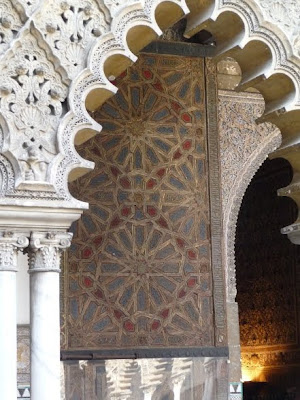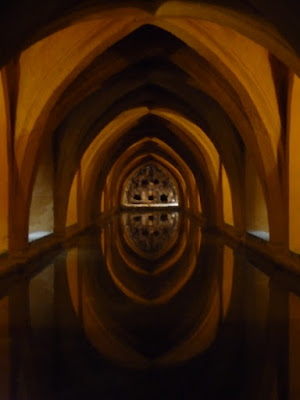 |
Tile ceiling dome in one of the rooms |
 |
Columns, arch, tiles... |
 |
Courtyard and water feature |
 |
Gardens |
 |
Another water feature, this one the baths of the female royalty (and friends) |
...recounts the retirement travels of Mark and Vicki Sherouse since 2008...in Asia and the Pacific, New Zealand, Europe, South America, and Africa, as well as the US and Canada. Our website, with much practical information, is: https://sites.google.com/site/theroadgoeseveron/.Contact us at mark.sherouse@gmail.com or vsherouse@gmail.com.
 |
Tile ceiling dome in one of the rooms |
 |
Columns, arch, tiles... |
 |
Courtyard and water feature |
 |
Gardens |
 |
Another water feature, this one the baths of the female royalty (and friends) |
 |
Seville Cathedral
|
 |
Ceiling at the crossing
|
 |
Largest altar in Christendom; I wonder if the
people of Peru or Mexico would like to have
some of their gold back
|
 |
Silver (spare) altar piece; 3,500 lbs.
|
 |
Moorish depiction of the Giralda, as it was
before the reconquista
|
 |
The huge choir blocks any possible view
from one end to the other; can't let the
common people see what's going on on the
other side....
|
 |
The poorly-lit Big Attraction...the tomb of Cristobal Colon,
who sailed the ocean blue, in 1492; now what do you think
of that?
|
 |
Ceiling of one of the side chapels
|
 |
Column in side chapel depicting agonies of hell...
something we always look for
|
 |
The cloisters, now sort of an orangerie, but was originally
the ablution court for the mosque; Moorish irrigation bricks
still in place
|
 |
On the Avenue El Cid; sure enough, looks just like Charleton Heston |
 |
On the Avenue Constitucion (or close) is a humongous, stately building that used to be a cigar factory, employing some 10,000 persons...where Carmen worked... (Nietzsche's favorite opera) |
 |
The convent bakery outlet, where we purchased some fine muffins |
 |
Don Juan; interesting that the city's two most famous personages are fictional...and the subjects of opera... |
 |
The old town is a city of plazas and patios, this one beautiful and relatively typical |
 |
Where Murillo lived |
 |
The Bodega de San Something or Otre; very popular despite smallish drinks |
 |
The bar where, for 2 euros, I had a beer and a plate of very decent paella marisco; the bartender was a big Obama fan (as are nearly all foreigners) |
 |
The main landmark, the Giralda, the now Christianized Moorish minaret, outside the cathedral |
 |
River front |
 |
In 1929, Seville hosted a world fair; many of the national pavillions remain, now restaurants, museums, galleries; this one Peru |
 |
Of course, once you get out of the old city, it's apartment- world, and supporting infrastructure, mile after mile, sort of a mini-China |
 |
The coast at Amarcao de Pera |
 |
The land forms here are sandstone, with golden sandy beaches, much gentler surf than the west coast we saw |
 |
But then, behind the beaches and the RV encampments, you have the condos; mile after mile of condos |
 |
And condo construction |
 |
Some of the architecture is, um, interesting |
 |
But, then, some of the RVs are, um, interesting, too |
 |
Our pitch at TurisCampo in Lagos; we have found Portguese
campgrounds, whether private or municipal, to be excellent
in every way
|
 |
Plus the tile work everywhere is attractive
|
 |
After a few days at Lagos, we moved back to Sagres, first atop
the windy Capo Sagres and the Promontorium Sacrum
|
 |
And revisited Sagres harbor, where a well-fed kitty surveys her
domain
|
 |
Well-fed seagulls guard the Doca Pesca
|
 |
And the business of the harbor carries on
|
 |
And then we moved back to the aire overlooking the cove and
stayed three nights at Surf City, the lower (paved) tier where
the surfers hang out
|
 |
When not surfing
|
 |
We visited a couple of beaches north of Sagres, wild, windy, but beautiful places, cliffs, breakers, broad beaches... |
 |
At one of the beaches, this interesting vehicle turned in, then headed back up the hill; looks like the ultimate land cruiser... I want one for our African/South American travels! |
 |
Incredible coastal scenery |
 |
Really wild surf |
 |
Fishing the big waters |
 |
Of course, one of the things they do have in Portugal is Portugese- Man-O-War...it's so impressive that they can swim all the way to Miami Beach! |
 |
Driving up to the fortress/visitor center
|
 |
Cape San Vicente (Promontorium Sacrum, the Romans called it)
in the distance...even wilder wind and wave
|
 |
I don't think they bought this one at Pier 1
|
 |
This item does remain from the school, although no one knows
what it was for: wind compass? sun dial?
|
 |
An interesting and apparently aged device up on the battlements
|